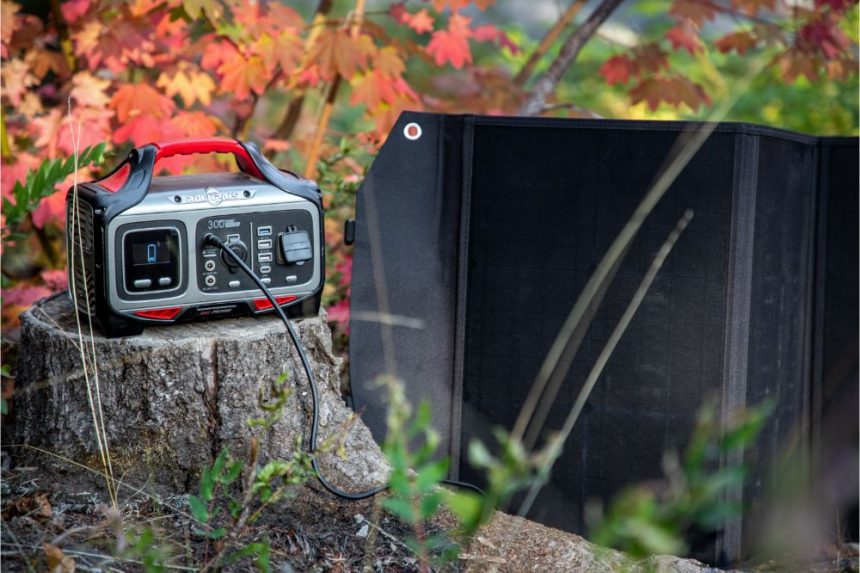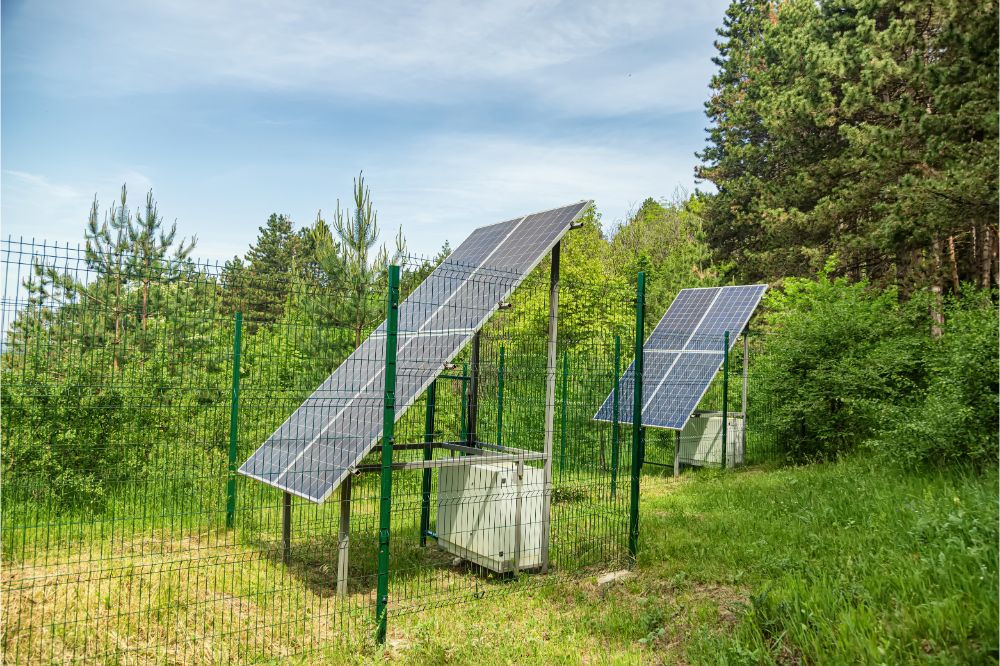Answering, “What is a solar generator?” can make a massive difference to how you experience the outdoors.
Whether you’re living off-grid or venturing into the wilderness for a weekend trip, these portable power stations are game-changers.
With access to a direct current of clean energy, your solar power generator is more than a backup power source; it’s access to continuous, renewable energy.
Let’s explore what makes solar energy a great alternative to gas-powered generators.
We’ll also dive into how they can offer extra electricity in a pinch while powering your must-have appliances and devices.
What Is a Solar Generator?
In summation, solar generators are portable power stations that require solar panels.
Some units come with separate solar panels, while others may have the panels built onto the device’s exterior.
They offer a renewable energy source in the event of a power outage while offering constant energy for a period of time.
Solar generators come in many shapes and sizes but are often much smaller than gas generators.
They’re also known to produce zero air pollution, helping you avoid contributing to climate change.
With solar batteries, you’ll have a reasonable battery capacity that’s helpful outside of being an emergency backup.
Many modern models come with built-in lithium-ion batteries, which hold a remarkable charge for an extended period.
As such, you can power coffee machines and air conditioners, have hot water, and more.
Not to mention they’re considerably quieter than traditional gas-powered generators and can be kept indoors.
How Do Solar Generators Work?
The way solar generators transform the sun’s rays into usable electricity is fascinating.
It’s an easy-to-understand four-stage process that gives plenty of electrical power without the need for gasoline.
Step 1: Collecting the Sunlight
The first step that solar generators go through is collecting sunlight.
As mentioned, some units have solar panels built onto themselves, but this is usually for those with lower power outputs.
You’ll need standalone solar panels if you’re looking for a portable power generator for high-powered appliances.
By connecting the solar panels to the power banks, the sun will be brought from the panel to the battery using a solar charging cable.
Step 2: Converting to Power
Once the solar panels absorb direct sunlight, the solar charging cable converts it into electrical power.
Step 3: Storing the Electrical Power
Solar generators are a fantastic backup energy supply because they store high electrical power reserves.
Each converted watt is then kept inside a lithium battery, which can be used immediately or later to power your appliances.
Lithium-ion batteries are highly reliable and are known to maintain their reserves considerably longer.
Step 4: Offering Power Support
The final step to understanding how these energy solutions work is how they power your appliances.
Most solar generators have an assortment of outputs, such as USB and DC ports.
The unit pushes power to your appliances and electronics once you connect them to these ports.

What Are the Differences Between Solar Generators and Traditional Generators?
Knowing their differences can be helpful if you’re on the fence between a gas-powered generator and a solar generator.
Solar generators are a cleaner source of energy and help preserve fossil fuels while offering quick charges for devices.
Let’s examine a few of the most notable differences between the two.
Noise – Winner: Solar Generator
One thing most outdoors enthusiasts know about traditional gas generators is how noisy they can be.
Many units have noise ratings well above 57dB, which can interrupt nature while also being a distraction to your relaxing vacation.
A solar generator can be a far better alternative if you want a more peaceful environment.
Many top-rated solar generators have noise levels hovering around 7dB, a considerable improvement from older gas models.
You’ll find it will be much less of a disruption to the animals around you while also keeping your campsite serene.
Emissions – Winner: Solar Generator
Another massive difference between solar and gas-powered generators is their emissions.
Solar generators are renewable power sources that use the sun.
Meanwhile, gas-powered units require liquid fuel, which can be expensive and burdensome to the environment.
Using solar generators at home or outdoors can eliminate harmful emissions and reduce your carbon footprint.
Not to mention they can also be used indoors, as they don’t have toxic fume outputs to consider.
Installation – Winner: Solar Generator
When you’re heading outdoors, the last thing you want is a device that’s challenging for you to set up.
Solar generators often have a plug-and-play design, meaning you simply connect a few wires and are good to go.
Gas-powered generators are a hassle because you need liquid fuel, have to constantly check fuel levels, and spend more time getting the device started.
This is particularly important to consider if you like camping in cold weather. Since you don’t have to prime solar generators, they start the first time, every time.
Gas-powered generators can be more challenging to get going if it’s cold.
Power Output – Winner: Undecided
In the past, gas-powered backup generators were often considered the most powerful option.
In some instances, this could ring true as gas-powered appliances can offer higher power outputs as they rely on gas rather than solar energy.
With modern technological advancements, solar standby generators are becoming more powerful.
Many high-end solar power stations offer equal power levels to their gas counterparts.
Although they may be more expensive solar solutions, the higher the power output, the more convenient they’ll be to have.
Emergencies – Winner: Solar Generators
No doubt solar technologies are a far better solution than gas when it comes to emergencies.
As the device absorbs solar power, your key appliances will have plenty of reserve power available, even as the sun goes down.
With gas, once you run out of fuel, there’s no way to recharge or refill the unit in a pinch.
Another massive benefit of solar generator batteries is portability. You can bring them with you anywhere, always keeping you connected.
Gas-powered devices are incredibly hefty and often not recommended for travel.
Are There Disadvantages to Solar Generators?
By now, it’s easy to see why solar power stations can be preferred for quiet operation, emergencies, and reducing emissions.
However, as with any type of technology, there are also a few disadvantages to consider.
Upfront Cost
By far, the largest downfall to solar solutions, especially compared to traditional generators, is their upfront cost.
Far more technology goes into designing solar power stations, which increases manufacturing costs.
As a result, this also increases the price for consumers, especially if you choose models with many bells and whistles.
However, you’ll also be investing more money into traditional generators over time, as they require more repairs.
Also, solar panels are known to offer many savings to help offset their upfront costs, possibly making them a more effective long-term solution.
Varying Power Supply
When shopping for solar power stations, it’s important to consider the power rating of every model.
Otherwise, you may find yourself with a low-powered clean power source.
There are thousands of solar generators on the market; some offer long-lasting power, while others provide minimal power output.
Lower-powered models might give you enough energy to recharge your smartphone a few times.
On the other hand, more expensive models come with long-lasting power that can run refrigerators, freezers, coffee machines, and more.
Paying close attention to the power ratings of each unit can guarantee you have a long-lasting clean power source.
Recharging
The largest concern with solar backup power systems is their recharging.
Typically, the more power it produces, the longer it will take to recharge using the sun.
Fortunately, this can often be addressed by using more solar panels, but this can increase your upfront costs considerably.
Depending on the model, you may find it could take over eight hours to get a full charge.
This is where gas-powered generators come in handy, as they don’t need to recharge and are ready to use as long as you have fuel.
How Can I Choose the Best Solar Generator?
With a good idea of what solar generators are and how they work, it’s time to consider what features your chosen model should have.
There are a few key details an all-in-one solar power kit needs to be the most helpful for all outdoor excursions.
Weight
Weight is important when you need power while camping, as you won’t want to carry a hefty unit around.
Try to find a model under five pounds, as the lighter they are, the easier they are to use.
Battery Capacity
Besides power output, battery capacity is another must-have for always-ready, expandable power.
Your backup power generator will need a high Watt-hour and Watt rating.
Charge Controller
All solar battery power stations have charge controllers, which determine how quickly the unit recharges.
Always check for MPPT charge controllers, which are the most efficient and reduce recharging time.
Solar Panels
Another key feature to consider with these backup power options is if they come with solar panels.
Many models do, while others will require you to buy the panels separately.
Monocrystalline panels are a fantastic option, as they are the most efficient.
It’s Time to Upgrade to a Solar Generator Today!
With an answer to “What is a solar generator?” it’s easy to see how it’s the best backup power source option.
It’s ideal for off-grid living, camping, and even tailgating with zero emissions and low noise operations.
If you need additional power and green energy, it’s time to invest in one of these powerful units today.

